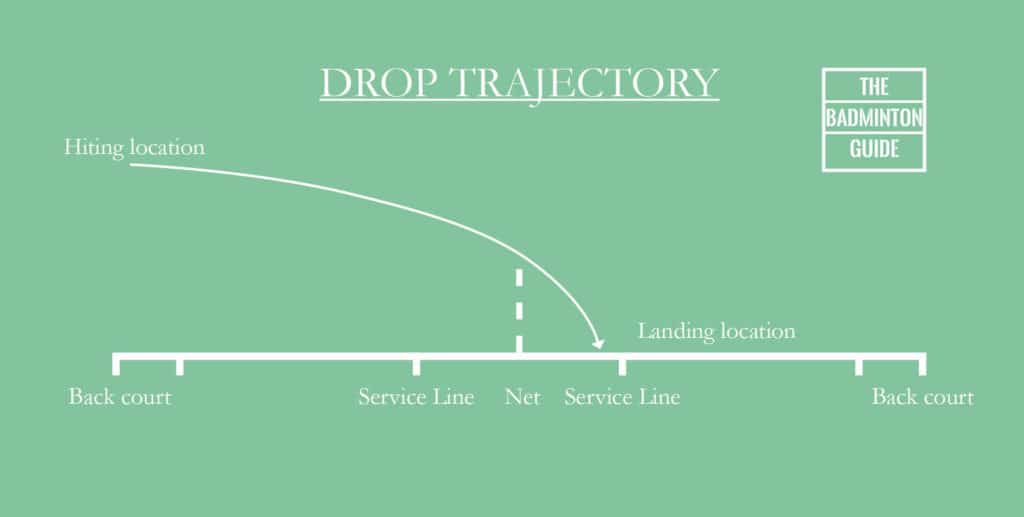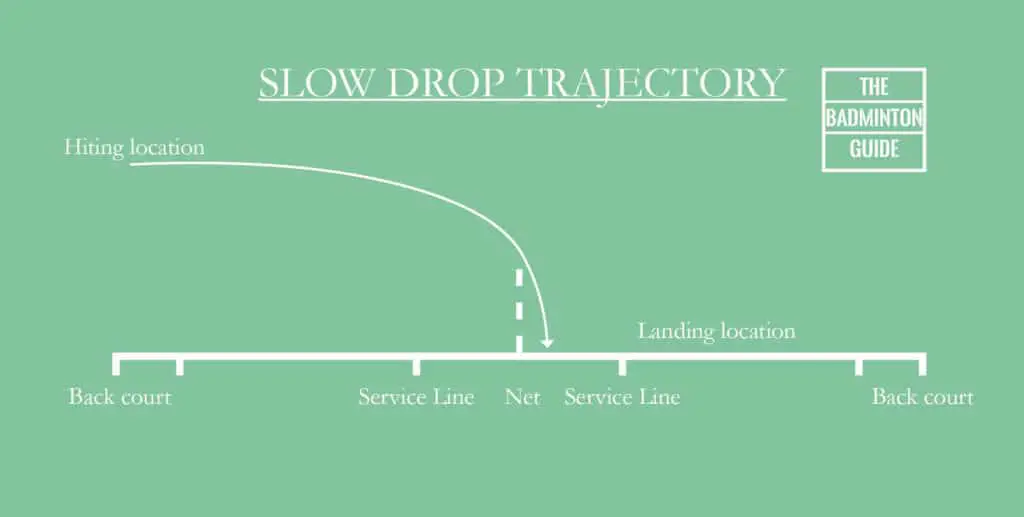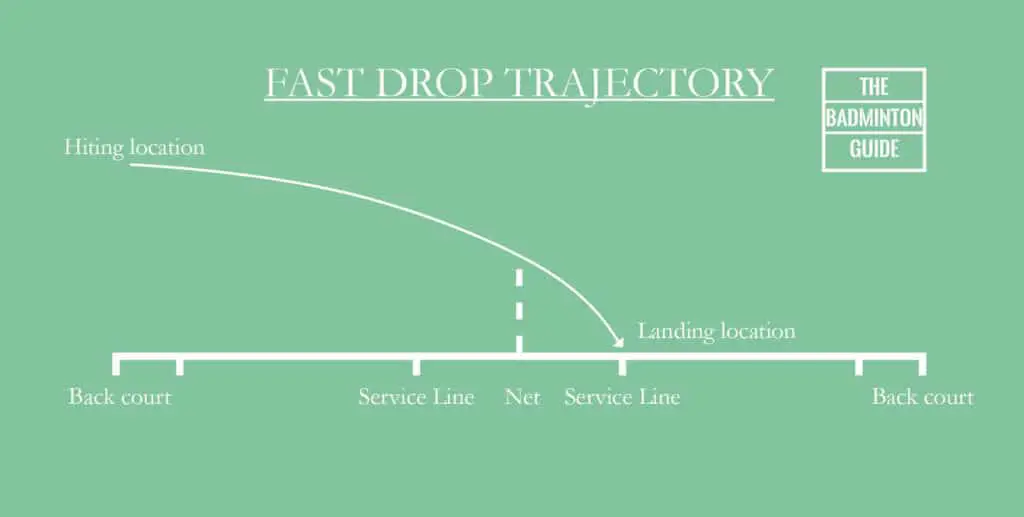I was trying to find online a good definition of what a backhand drop shot in badminton is. Since I couldn’t really find any, I have written this post to answer that question.
So, what is a backhand drop shot in badminton? A backhand drop shot in badminton is a shot performed with your backhand and from the back part of the court. It has a downwards and curved trajectory and it directed to the front of the court of your opponent.
Do you want to improve your badminton game? Then be sure to sign up for Badminton Famly+ by clicking here. Founded by former World Champion Thomas Laybourn, Badminton Famly+ is the best online training platform for badminton.
In the image below you can see a drawing of the trajectory of a badminton drop shot. If you want to learn a bit more about what a backhand drop is or when to use one, be sure to read on.

What Is a Backhand Drop Shot in Badminton? – The In-Depth answer
As I said before, the backhand drop shot in badminton is a shot that you do with your backhand grip and from the back part of the court. It has a downwards and curved trajectory and it directed to the front of the court of your opponent.
QUICK TIP: If you don’t know what a backhand grip is, be sure to check our Badminton Grip Guide.
Even though the drop shot as a shot is seen as an offensive shot, the backhand drop shot should be seen more as a recovery shot. This is because the backhand shots should never be your first option. They are always more difficult to perform and weaker options, so you should always try to perform an overhead forehand shot if possible.
This type of drop shot is mostly used in singles.
In doubles, usually, you will not reach a point where, on the back of the court, you are so forced that you need to use your backhand. If you do, my only choice would be a fast drop shot ( more on this later). If your backhand is strong, you might consider also using a clear shot instead. This will give you time to recover and reposition yourselves and try to regain the initiative in the coming shots.
In singles, as I said before, the main goal of this shot is to recover the position without giving up too much. So, when you perform this shot, you should be trying to get back to the base position as fast as possible and do your best to get the shuttle in a better position the next time.
Having said that, if you master this shot, you can also make some offensive shots with it. The one I have personally found most useful is the cross-court shot. Opponents do not usually expect it and, if you manage to master it, it can be a powerful tool to use. Even more powerful because the alternatives for a backhand shot are usually bleak.
In the following sections, we will go into detail in the different types of backhand drop shots that exist, including the cross court one I have just mentioned.
What are the different types of backhand drop shot in badminton?
The backhand drop shot can be divided into two types:
- Basic backhand drop shot
- Slice backhand drop shot
Basic or slow backhand drop shot
The basic or slow backhand drop shot is done with a backhand grip, on the non-racket side of the body. This shot can be parallel or crosscourt.
This is a good solution if your backhand is not strong enough to return a clear, but you are forced to use the backhand. In this case, having a good backhand drop will help you lessen the pressure your opponent is putting on you.
This shot will be the perfect definition of the recovery shot I was mentioning before.

Slice or fast backhand drop shot
The slice or fast backhand drop shot is done with a backhand grip, on the non-racket side of the body. This shot can be parallel or crosscourt.
This is a good solution if your backhand is not strong enough to return a clear, but you are forced to use the backhand. This is the shot I mentioned before that I use a lot. Because it is a fast drop shot, my opponents have a hard time keeping the initiative after I have performed it, so I usually manage to get out of a tricky situation with it. The one that I use the most is the crosscourt version because I can control it more and my opponents expect it less.

If you are curious about how you should be performing these shots, check our Badminton drop shot post, where I give you a step-by-step guide on how to perform each of the shots.
Alternatively, these two videos below also explain the basis of certain types of backhand drop shots very well.
When to use the backhand drop shot in badminton?
Being a recovery shot in most cases, you shouldn’t be using this shot too often. Otherwise, it means either that your opponent is having the upper hand or that you are not prioritizing which type of shot you should be performing.
When to use the backhand drop shot in singles?
You should be using the backhand drop shot in singles whenever you cannot reach the shuttle with an overhead forehand stroke. If that is the case, then you are losing the initiative of the point. Therefore, you should be doing the backhand drop shot to try to recover the initiative by returning fast to the base point and reaching the shuttle faster in the next shot.
The backhand drop shot is a good exit point if your backhand is not very strong and you have troubles reaching the back of the court with it. This is the case for the majority of beginner and intermediate players, so don’t worry if that is your case.
Since you cannot perform a backhand clear that would get you out of the situation without leaving yourself very exposed, the drop shot will be a big help.
So, whenever you have lost the initiative, you are reaching the shot with a backhand stroke and your backhand clear is not very good, the backhand drop shot should be your primary choice. If your backhand clear is good, backhand drop shots should still be used in order to maximize the variability of your shots.
When to use the backhand drop shot in doubles?
In doubles this shot will not be used very often. Since there are two people on the court, a good court coverage should ensure that you are not caught with the need to perform a backhand stroke.
If you do, though, my personal advice is to only use the fast drop shot and never use the slow one. Why? Because your opponents will be pressuring the net, a slow drop shot will most likely get you “killed” because your opponents will have plenty of time to reach the shuttle and attack it.
The fast drop shot, on the other hand, should be passing very close to the net, so the chances of it being attacked are smaller. However, your priority in this situation should be for the shuttle to pass as close to the net as possible and not being very precise on the exact location of the landing.
As an alternative to the fast drop shot, if you have a strong enough backhand, you can consider using a backhand clear shot instead. With this shot, you and your partner will have time to reorganize yourselves in a defensive stance and try to regain the initiative in the next shots.
Final words
And with this, we have arrived at the end of this post. If you enjoy this post and you would like to have a bit more information about how to perform a drop shot, you can go to our Badminton Drop Shot Guide, where we have a step-by-step guide on how to perform all the different types of drop shots.
If you still have doubts about the backhand drop shot, please let me know in the comments below.
This file is licensed under the Creative Commons license “Attribution-ShareAlike 4.0 International”.
Attribution: alainalele, Flickr, CC BY-SA 4.0
